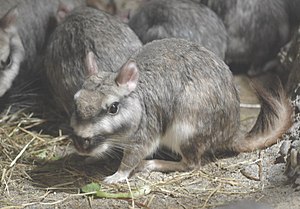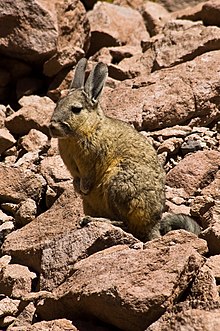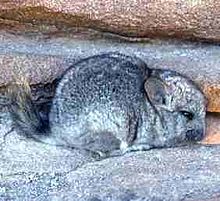Chinchillas
| Chinchillas | ||||||||||||
|---|---|---|---|---|---|---|---|---|---|---|---|---|

Viscacha ( Lagostomus maximus ) |
||||||||||||
| Systematics | ||||||||||||
|
||||||||||||
| Scientific name | ||||||||||||
| Chinchillidae | ||||||||||||
| Bennett , 1833 | ||||||||||||
| Genera | ||||||||||||
|
The chinchillas (Chinchillidae) are a family of rodents living in South America . This comprises three genera. In addition to the real chinchillas , known as fur suppliers and pets, there are also the rabbit mice and viscachas with a total of seven species.
description
Chinchillas are medium-sized rodents that are characterized by a slender body with thick, soft fur and a long, bushy tail. The fur is gray or gray-brown in color, with the underside being lighter. Their heads are large and have a wide muzzle, their eyes are large and their ears elongated. The front legs are short and the front feet have four toes. The hind legs are significantly longer and more muscular and end in three (Viscacha) or four (rabbit mice and real chinchillas) toes. These animals reach a head body length of 23 to 65 centimeters and a tail length of 8 to 40 centimeters. Their weight is between 500 grams and 8 kilograms.
The tooth formula is like all guinea pig relatives I 1- C 0- P 1- M 3, so a total of 20 teeth. As with all rodents, the incisors are incisor teeth , but they are relatively small, and the molars are also rootless .
distribution
Chinchillas are native to western and southern South America, their distribution area includes southern Peru , Bolivia , Argentina and Chile .
Way of life
Actual chinchillas and rabbit mice are inhabitants of mountainous regions, while Viscachas live on grassy plains. All species tend to be nocturnal; they use caves, crevices or, in the case of the Viscachas, self-dug burrows as shelter. All species live together in groups, the size of which can vary from a few animals to several hundred. All species are herbivores. The chinchilla can splash urine in dangerous situations and also lose its fur, leaving the enemy with only a tuft of hair.
Chinchillas and people
Actual chinchillas are widespread as pets and as suppliers of chinchilla fur and are also kept on farms. In the wild, the population of all species has been severely decimated by habitat destruction and hunting. The short-tailed chinchilla is considered critically endangered.
Systematics
External system
The chinchillas are counted among the guinea pig relatives within the rodents . Due to external similarities, the chinchilla rats (Abrocomidae) were previously thought to be close relatives of the chinchillas, but recent studies contradict this. Similarities in the tooth pattern and molecular genetic studies suggest that the Pakaranas ( Dinomyidae ) should be regarded as the closest relatives of the chinchillas.
Internal system
The chinchillas are divided into three genera with seven species:
- Actual chinchillas ( chinchilla ) with two species,
- Rabbit mice or mountain viscachas ( Lagidium ) with four species,
- Viscacha ( Lagostomus maximus ).
Actual chinchillas and rabbit mice are more closely related and are sometimes united in the subfamily Chinchillinae, which is opposite to the Viscacha (Lagostominae).
Origin of name
The name chinchilla is of native origin, some other theories are obviously wrong. In the language of the Andean Chincha people , the so-called Aymara , the animal name was already known when the western part of South America was conquered , beginning in 1532. The original connections between the common name chincha and the animal name chinchilla are unclear.
literature
- Ronald M. Nowak: Walker's Mammals of the World. 2 volumes. 6th edition. Johns Hopkins University Press, Baltimore MD u. a. 1999, ISBN 0-8018-5789-9 .
- Don E. Wilson , DeeAnn M. Reeder (Eds.): Mammal Species of the World. A taxonomic and geographic Reference. 2 volumes. 3. Edition. Johns Hopkins University Press, Baltimore MD 2005, ISBN 0-8018-8221-4 .
Web links
Individual evidence
- ↑ J. Becker: On the origin of the name Chinchilla . In: Das Pelzgewerbe No. 3, 1971, Hermelin-Verlag Dr. Paul Schöps, Berlin et al., Pp. 34-35. Primary source: Bertoni, 1612.


